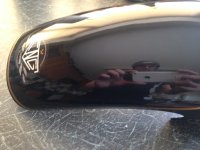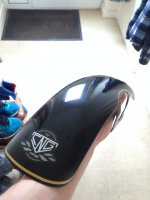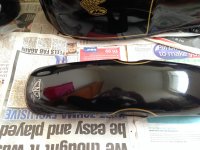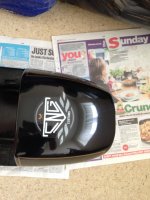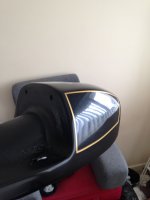We noticed you are blocking ads. DO THE TON only works with community supporters. Most are active members of the site with small businesses. Please consider disabling your ad blocking tool and checking out the businesses that help keep our site up and free.
You are using an out of date browser. It may not display this or other websites correctly.
You should upgrade or use an alternative browser.
You should upgrade or use an alternative browser.
'73 CB250 - Doing it right this time round.
- Thread starter Green199
- Start date
Green199 said:Lacquer. Wanted to use 2 pack but couldn't really get hold of any.
After it's done curing, finish with a two part clear coat or you'll regret it.
Even a drop of gas or brake fluid will ruin lacquer in a heat beat.
I used a petrol resistant lacquer. I used it on the tank of my SV and its held up pretty well to fuel so far. Any drops from filling up I simply wiped off with my glove and there isn't any discoloration or anything so far.
Do you have any tips for polishing Matt?
Do you have any tips for polishing Matt?
Erskine
Over 1,000 Posts
teazer said:XB,
"Fizzy" is an FS1E 50cc Yamaha moped that was popular with hooligans back in the day
I was that hooligan.
My rubbing compound came in. Not sure what to say about it. Wet-sanded and removed all the orange peel, then used the rubbing compound to try and bring out the shine.
It did make it much less dull, as you can see in the photos. But what you can't see is that its all scratched to shit. Can't see it in the photos, but in person it does not look good at all.
You can see some scratches in the reflection of the light in the 2nd picture.
I tried it on the tank and it really hasn't brought out any shine at all. I'm guessing I'm gonna have to find some finer compound/polish to try and fix it.
It did make it much less dull, as you can see in the photos. But what you can't see is that its all scratched to shit. Can't see it in the photos, but in person it does not look good at all.
You can see some scratches in the reflection of the light in the 2nd picture.
I tried it on the tank and it really hasn't brought out any shine at all. I'm guessing I'm gonna have to find some finer compound/polish to try and fix it.
Attachments
I do all of my motorcycle and other small paint jobs by hand. The only times I break out the equipment is for cars.
deviant said:I do all of my motorcycle and other small paint jobs by hand. The only times I break out the equipment is for cars.
Would you care to talk through your process deviant?
What results do you get?
It's a bit labor intensive, but basically I wet sand up to 2000 grit. You have to watch your water, so I do it in a trough. As long as the slurry comes off clear or milky, you're golden. You're just making sure you don't start seeing your color. Make sure you aren't sanding in one spot more than others to keep a consistent depth. As long as the orange peel isn't too high, you can start with 600 and work up from there. I make sure I dry it between grits to see where I'm at. As you sand through the texture, you'll see where it's shiny and matte, with the shiny spots being the low spots. As soon as it's a consistent matte surface, I move up to 800, then to 1000. Just a couple of minutes of 1000 polishing will let you know if there are still 600 marks. Drying to check will reveal. then 1200, 1500, 2000. After 2000, apply rubbing compound with a damp pad. Buff it really well. Then wash that off really well. Usually rubbing compound is red, so I make sure I have no red anywhere in seams and whatnot. Then 3M hand glaze after the rubbing compound and it should shine like a diamond. If there are any scratches left from the coarser grit papers, usually you can use a scratch care type polish to work them out. The main thing is wash and dry between steps and monitor your progress. Sometime, you can skip a grit or start higher, depending on how well you wet your final layer of clear.
+1, great info here...pretty much what I do for guitars and bikes. Can be done by hand for sure, but even a little foam bonnet on a drill can speed things up considerably for the finally buffing and swirl removal. Meguiars Scratch X swirl remover is money for final buffing IMO.
deviant said:It's a bit labor intensive, but basically I wet sand up to 2000 grit. You have to watch your water, so I do it in a trough. As long as the slurry comes off clear or milky, you're golden. You're just making sure you don't start seeing your color. Make sure you aren't sanding in one spot more than others to keep a consistent depth. As long as the orange peel isn't too high, you can start with 600 and work up from there. I make sure I dry it between grits to see where I'm at. As you sand through the texture, you'll see where it's shiny and matte, with the shiny spots being the low spots. As soon as it's a consistent matte surface, I move up to 800, then to 1000. Just a couple of minutes of 1000 polishing will let you know if there are still 600 marks. Drying to check will reveal. then 1200, 1500, 2000. After 2000, apply rubbing compound with a damp pad. Buff it really well. Then wash that off really well. Usually rubbing compound is red, so I make sure I have no red anywhere in seams and whatnot. Then 3M hand glaze after the rubbing compound and it should shine like a diamond. If there are any scratches left from the coarser grit papers, usually you can use a scratch care type polish to work them out. The main thing is wash and dry between steps and monitor your progress. Sometime, you can skip a grit or start higher, depending on how well you wet your final layer of clear.
deviant said:It's a bit labor intensive, but basically I wet sand up to 2000 grit. You have to watch your water, so I do it in a trough. As long as the slurry comes off clear or milky, you're golden. You're just making sure you don't start seeing your color. Make sure you aren't sanding in one spot more than others to keep a consistent depth. As long as the orange peel isn't too high, you can start with 600 and work up from there. I make sure I dry it between grits to see where I'm at. As you sand through the texture, you'll see where it's shiny and matte, with the shiny spots being the low spots. As soon as it's a consistent matte surface, I move up to 800, then to 1000. Just a couple of minutes of 1000 polishing will let you know if there are still 600 marks. Drying to check will reveal. then 1200, 1500, 2000. After 2000, apply rubbing compound with a damp pad. Buff it really well. Then wash that off really well. Usually rubbing compound is red, so I make sure I have no red anywhere in seams and whatnot. Then 3M hand glaze after the rubbing compound and it should shine like a diamond. If there are any scratches left from the coarser grit papers, usually you can use a scratch care type polish to work them out. The main thing is wash and dry between steps and monitor your progress. Sometime, you can skip a grit or start higher, depending on how well you wet your final layer of clear.
Thanks for that. I didn't have a lot of orange peel to begin with, so I started with 2500 grit, then moved to 3000. It got rid of all of it quite easily which I was surprised about.
When you say apply compound then buff really well, is this in circles, or in straight lines alternating like wetsanding?
I've got a feeling my rubbing compound may have been a bit course as it has loads of tiny little scratches in the light. I'm guessing the 3M hand glaze you mention would be to take these out? Like Meguairs scratch X.
I'm just about worried about getting a polish or scratch remover when I have so many scratches covering all the parts. I will try and get a better picture in a second to show you what I'm working with.


